2004 SUBARU IMPREZA WRX wiper fluid
[x] Cancel search: wiper fluidPage 172 of 491
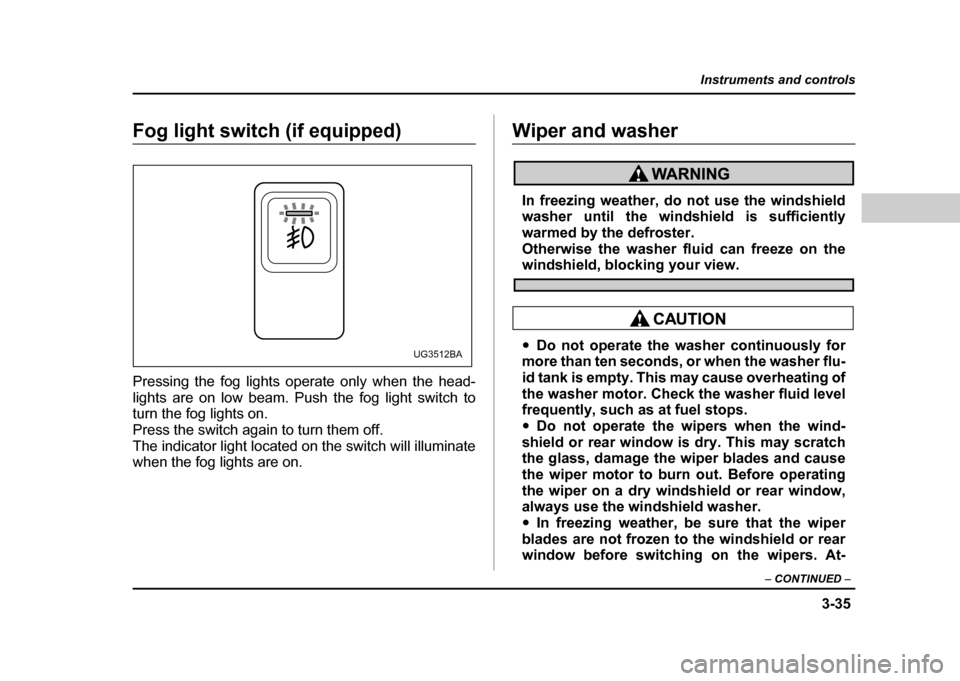
3-35
Instruments and controls
– CONTINUED –
Fog light switch (if equipped)
Pressing the fog lights operate only when the head-
lights are on low beam. Push the fog light switch to
turn the fog lights on.
Press the switch again to turn them off.
The indicator light located on the switch will illuminate
when the fog lights are on.Wiper and washer
In freezing weather, do not use the windshield
washer until the windshield is sufficiently
warmed by the defroster.
Otherwise the washer fluid can freeze on the
windshield, blocking your view.
"Do not operate the washer continuously for
more than ten seconds, or when the washer flu-
id tank is empty. This may cause overheating of
the washer motor. Check the washer fluid level
frequently, such as at fuel stops. " Do not operate the wipers when the wind-
shield or rear window is dry. This may scratch
the glass, damage the wiper blades and cause
the wiper motor to burn out. Before operating
the wiper on a dry windshield or rear window,
always use the windshield washer. " In freezing weather, be sure that the wiper
blades are not frozen to the windshield or rear
window before switching on the wipers. At-UG3512BA
Page 173 of 491
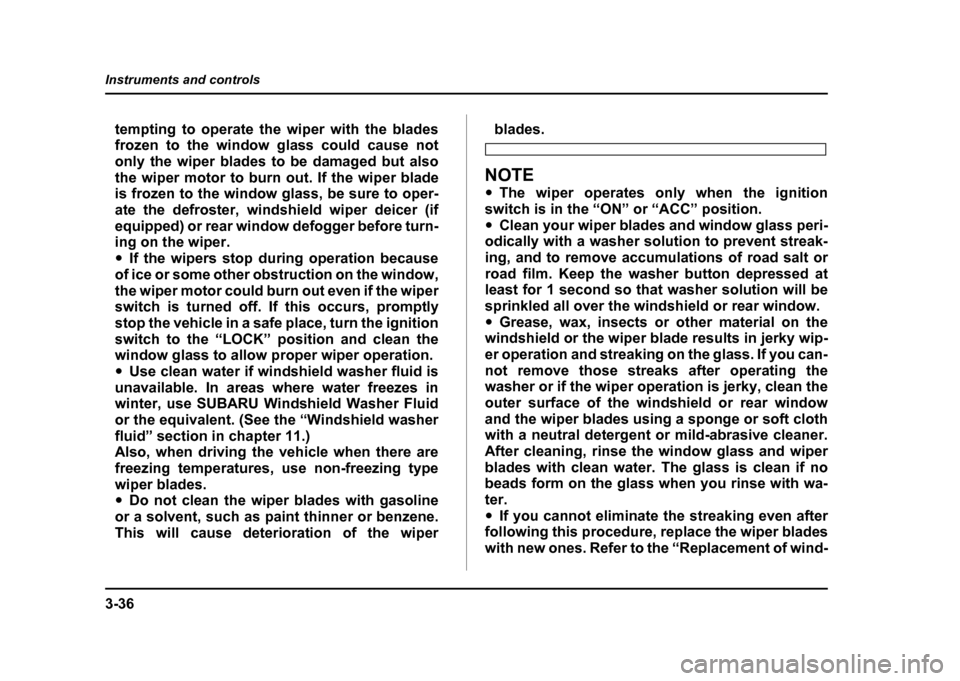
3-36
Instruments and controls
tempting to operate the wiper with the blades
frozen to the window glass could cause not
only the wiper blades to be damaged but also
the wiper motor to burn out. If the wiper blade is frozen to the window glass, be sure to oper-
ate the defroster, windshield wiper deicer (if
equipped) or rear window defogger before turn-
ing on the wiper. "
If the wipers stop during operation because
of ice or some other obstruction on the window,the wiper motor could burn out even if the wiper
switch is turned off. If this occurs, promptly
stop the vehicle in a safe place, turn the ignition
switch to the “LOCK” position and clean the
window glass to allow proper wiper operation. " Use clean water if windshield washer fluid is
unavailable. In areas where water freezes in
winter, use SUBARU Windshield Washer Fluid
or the equivalent. (See the “Windshield washer
fluid” section in chapter 11.)
Also, when driving the vehicle when there are
freezing temperatures, use non-freezing type
wiper blades. " Do not clean the wiper blades with gasoline
or a solvent, such as paint thinner or benzene.
This will cause deterioration of the wiperblades.
NOTE " The wiper operates only when the ignition
switch is in the “ON” or “ACC” position. " Clean your wiper blades and window glass peri-
odically with a washer solution to prevent streak-
ing, and to remove accumulations of road salt or
road film. Keep the washer button depressed at
least for 1 second so that washer solution will be
sprinkled all over the windshield or rear window." Grease, wax, insects or other material on the
windshield or the wiper blade results in jerky wip-
er operation and streaking on the glass. If you can-
not remove those streaks after operating the
washer or if the wiper operation is jerky, clean the
outer surface of the windshield or rear window
and the wiper blades using a sponge or soft cloth
with a neutral detergent or mild-abrasive cleaner.
After cleaning, rinse the window glass and wiper
blades with clean water. The glass is clean if no
beads form on the glass when you rinse with wa- ter. " If you cannot eliminate the streaking even after
following this procedure, replace the wiper blades
with new ones. Refer to the “Replacement of wind-
Page 175 of 491
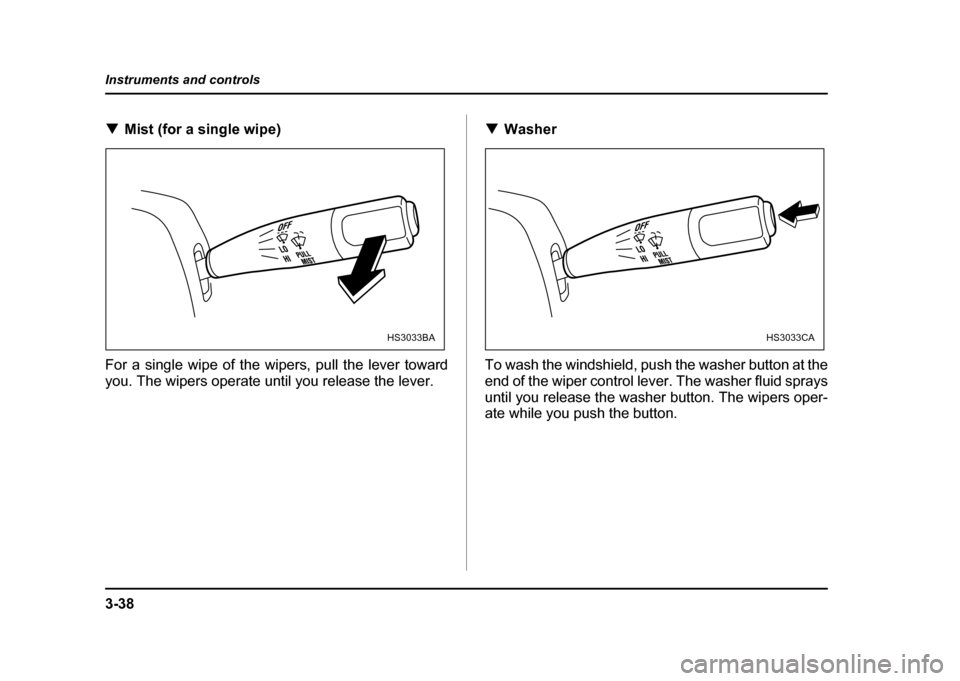
3-38
Instruments and controls
!
Mist (for a single wipe)
For a single wipe of the wipers, pull the lever toward
you. The wipers operate until you release the lever. !
Washer
To wash the windshield, push the washer button at the
end of the wiper control lever. The washer fluid sprays
until you release the washer button. The wipers oper-
ate while you push the button.
HS3033BAHS3033CA
Page 176 of 491
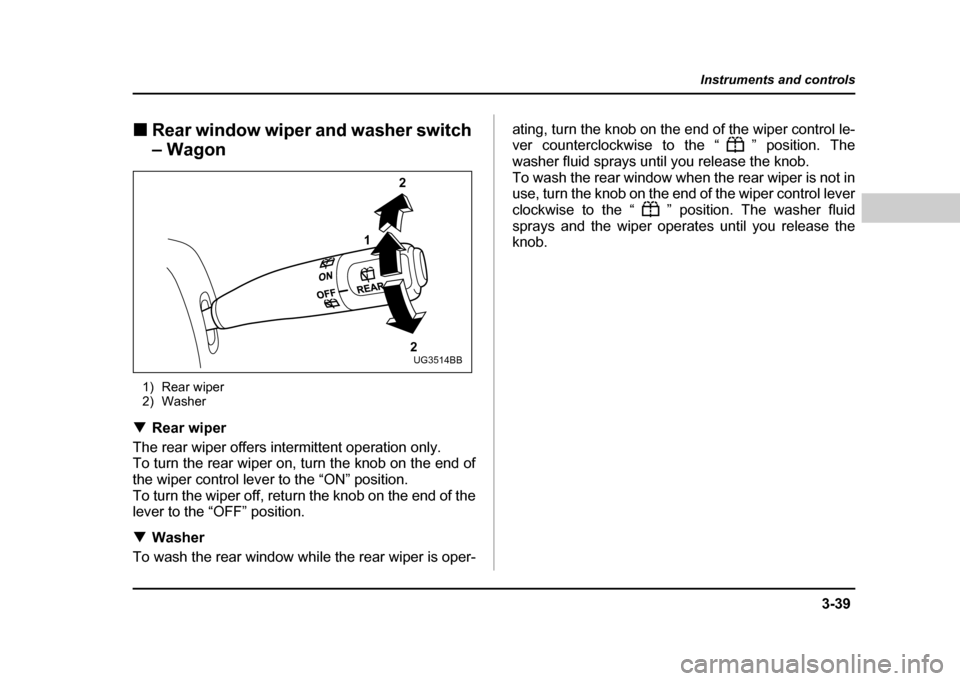
3-39
Instruments and controls
– CONTINUED –
!Rear window wiper and washer switch – Wagon
1) Rear wiper
2) Washer
! Rear wiper
The rear wiper offers intermittent operation only.
To turn the rear wiper on, turn the knob on the end of
the wiper control lever to the “ON” position.
To turn the wiper off, return the knob on the end of the
lever to the “OFF” position. ! Washer
To wash the rear window while the rear wiper is oper- ating, turn the knob on the end of the wiper control le-
ver counterclockwise to the “ ” position. The
washer fluid sprays until you release the knob.
To wash the rear window when the rear wiper is not in
use, turn the knob on the end of the wiper control lever
clockwise to the “ ” position. The washer fluid
sprays and the wiper operates until you release the
knob.
1
2
2
UG3514BB
Page 323 of 491
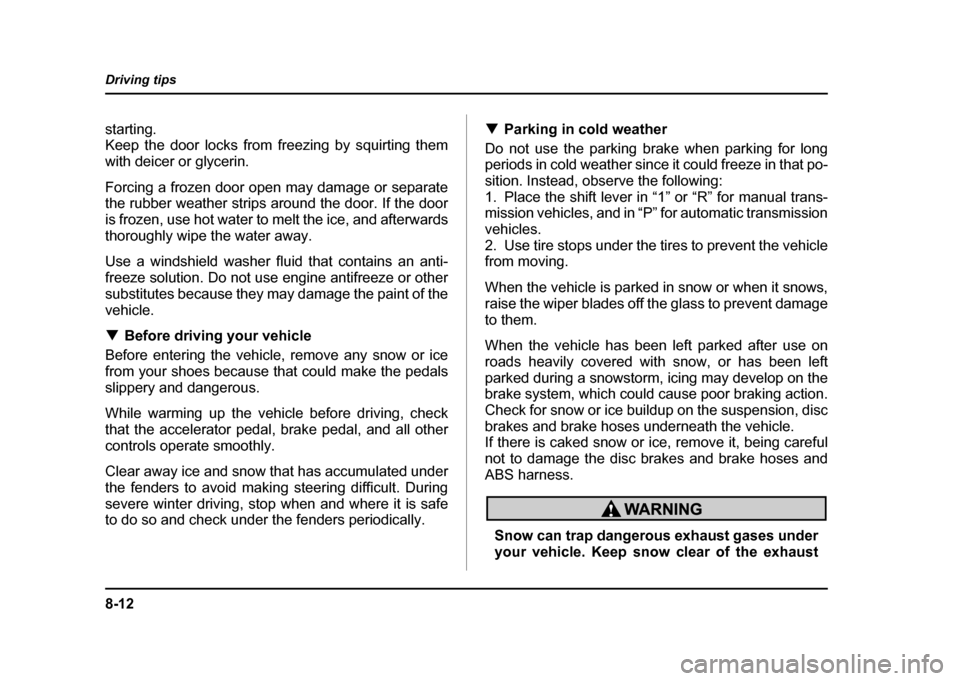
8-12
Driving tips
starting.
Keep the door locks from freezing by squirting them
with deicer or glycerin.
Forcing a frozen door open may damage or separate
the rubber weather strips around the door. If the door
is frozen, use hot water to melt the ice, and afterwards
thoroughly wipe the water away.
Use a windshield washer fluid that contains an anti-
freeze solution. Do not use engine antifreeze or other
substitutes because they may damage the paint of the
vehicle. !
Before driving your vehicle
Before entering the vehicle, remove any snow or ice
from your shoes because that could make the pedals
slippery and dangerous.
While warming up the vehicle before driving, check
that the accelerator pedal, brake pedal, and all other
controls operate smoothly.
Clear away ice and snow that has accumulated under
the fenders to avoid making steering difficult. During
severe winter driving, stop when and where it is safe
to do so and check under the fenders periodically. !
Parking in cold weather
Do not use the parking brake when parking for long
periods in cold weather since it could freeze in that po-
sition. Instead, observe the following:
1. Place the shift lever in “1” or “R” for manual trans-
mission vehicles, and in “P” for automatic transmission
vehicles.
2. Use tire stops under the tires to prevent the vehicle
from moving.
When the vehicle is parked in snow or when it snows,
raise the wiper blades off the glass to prevent damageto them.
When the vehicle has been left parked after use on
roads heavily covered with snow, or has been left
parked during a snowstorm, icing may develop on the
brake system, which could cause poor braking action.
Check for snow or ice buildup on the suspension, disc
brakes and brake hoses underneath the vehicle.
If there is caked snow or ice, remove it, being careful
not to damage the disc brakes and brake hoses andABS harness.
Snow can trap dangerous exhaust gases under
your vehicle. Keep snow clear of the exhaust
Page 387 of 491

11 - 2
Maintenance and service
Types of tires .................................................... 11-44
Tire inspection .................................................. 11-45
Tire pressures and wear .................................. 11-45
Wheel balance ................................................... 11-48
Wear indicators ................................................. 11-49
Tire rotation ....................................................... 11-50
Tire replacement ............................................... 11-50
Wheel replacement ........................................... 11-51
Wheel covers .................................................... 11-52
Aluminum wheels (If equipped) .................. 11-53
Intercooler water spray ................................ 11-53
Windshield washer fluid .............................. 11-54
Replacement of windshield wiper blades .. 11-55
Battery ........................................................... 11-58
Fuses ............................................................. 11-60
Main fuse ....................................................... 11-63
Installation of accessories .......................... 11-63
Replacing bulbs ............................................ 11-64 Headlights (U.S. spec. WRX-STi) .................... 11-66
Headlight (Except U.S. spec. WRX-STi) .......... 11-66
Front turn signal light bulbs ............................ 11-69
Parking light ...................................................... 11-70
Front fog light ................................................... 11-73
Rear combination lights ................................... 11-74
License plate light ............................................ 11-76
Dome light, map light and cargo area light .... 11-77
Trunk light ......................................................... 11-78
High mount stop light ...................................... 11-78
Page 440 of 491
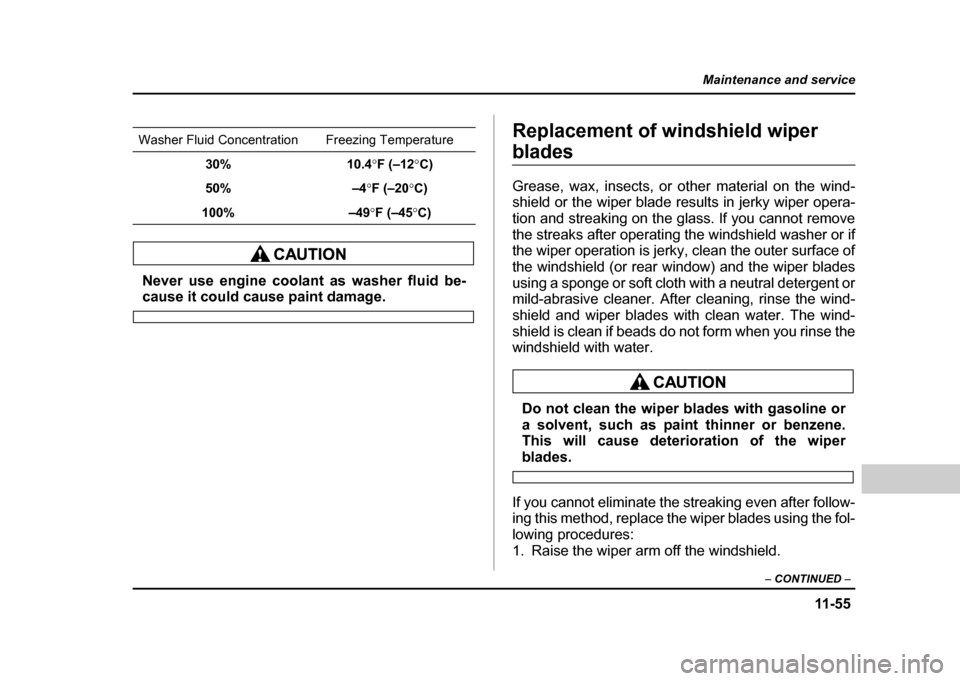
11 -5 5
Maintenance and service
– CONTINUED –
Never use engine coolant as washer fluid be-cause it could cause paint damage. Replacement of windshield wiper
blades
Grease, wax, insects, or other material on the wind-
shield or the wiper blade results in jerky wiper opera-
tion and streaking on the glass. If you cannot remove
the streaks after operating the windshield washer or if
the wiper operation is jerky, clean the outer surface of
the windshield (or rear window) and the wiper blades
using a sponge or soft cloth with a neutral detergent or
mild-abrasive cleaner. After cleaning, rinse the wind-
shield and wiper blades with clean water. The wind-
shield is clean if beads do not form when you rinse the
windshield with water.
Do not clean the wiper blades with gasoline or
a solvent, such as paint thinner or benzene.
This will cause deterioration of the wiper
blades.
If you cannot eliminate the streaking even after follow-
ing this method, replace the wiper blades using the fol-
lowing procedures:
1. Raise the wiper arm off the windshield.
Washer Fluid Concentration Freezing Temperature
30% 10.4 °F (–12 °C)
50% –4 °F (–20 °C)
100% –49 °F (–45 °C)
Page 443 of 491
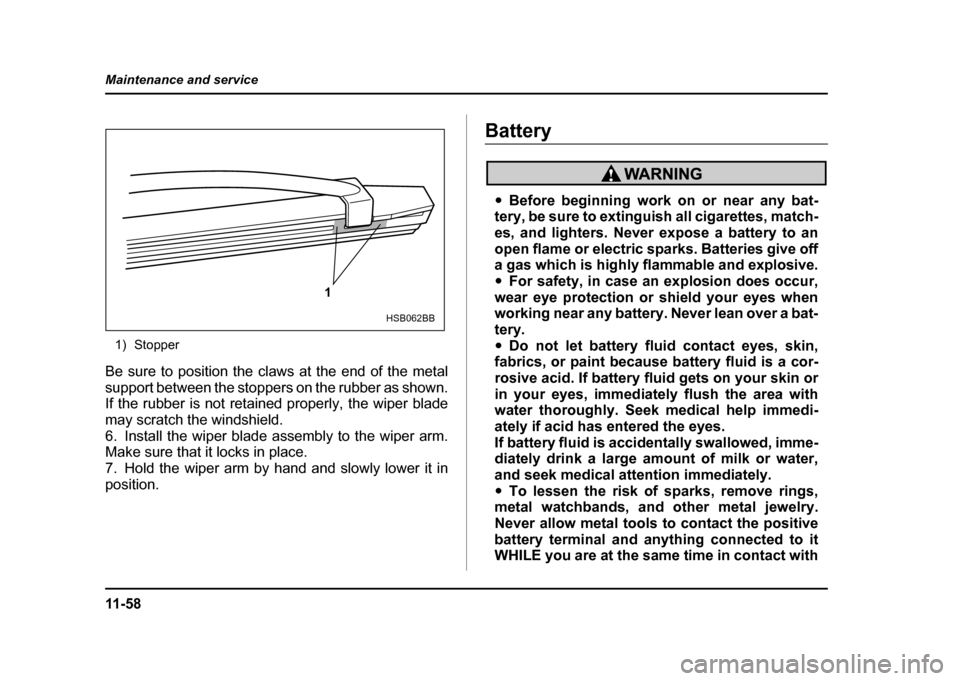
11 - 5 8
Maintenance and service
1) Stopper
Be sure to position the claws at the end of the metal
support between the stoppers on the rubber as shown.
If the rubber is not retained properly, the wiper blade
may scratch the windshield.
6. Install the wiper blade assembly to the wiper arm.
Make sure that it locks in place.
7. Hold the wiper arm by hand and slowly lower it in
position.
Battery
" Before beginning work on or near any bat-
tery, be sure to extinguish all cigarettes, match-
es, and lighters. Never expose a battery to an
open flame or electric sparks. Batteries give off
a gas which is highly flammable and explosive. " For safety, in case an explosion does occur,
wear eye protection or shield your eyes when
working near any battery. Never lean over a bat- tery." Do not let battery fluid contact eyes, skin,
fabrics, or paint because battery fluid is a cor-
rosive acid. If battery fluid gets on your skin or
in your eyes, immediately flush the area with
water thoroughly. Seek medical help immedi-
ately if acid has entered the eyes.
If battery fluid is accidentally swallowed, imme-
diately drink a large amount of milk or water,
and seek medical attention immediately." To lessen the risk of sparks, remove rings,
metal watchbands, and other metal jewelry.
Never allow metal tools to contact the positive
battery terminal and anything connected to it
WHILE you are at the same time in contact with
1
HSB062BB